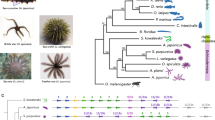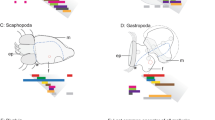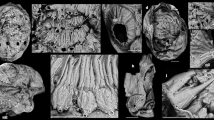Abstract
Dicyemids, which are microscopic parasites of squids and octopuses, have among the simplest body plans of all multicellular animals. They lack body cavities and almost all the organs that characterize animals, such as a gut or nervous system, and their development proceeds without germ layers and gastrulation. The adult body consists of a solitary axial cell surrounded by a single layer of 10–40 ciliated outer cells. Here we use information from Hox gene sequences to investigate the phylogenetic affinities of dicyemids, and conclude that dicyemids are lophotrochozoans that have secondarily lost many morphological characters, so the simplicity of their body plan is not a primitive condition.
Similar content being viewed by others
Main
Because of their simple body plan, dicyemids have long been the subject of phylogenetic controversy. They comprise most of the Mesozoa, a name that indicates a level of complexity intermediate between protists and Metazoa1. Alternatively, they have been suggested to be derived from parasitic platyhelminths2 (dicyemids are obligate symbionts found in the renal sacs of cephalopod molluscs) or placed within the protists3. Data from 18S-ribosomal DNA indicate that dicyemids may be related to triploblasts (bilaterians), although these analyses do not resolve whether dicyemids are primitive or degenerate triploblasts4. Dicyemids are recognized as primitive animals, although their phylogenetic placement relative to other basal taxa such as Porifera, Placozoa and Cnidaria is unclear.
We isolated genomic and complementary DNA clones for a Hox gene, DoxC, from the dicyemid mesozoan Dicyema orientale. We used high-stringency Southern-blot analysis and the polymerase chain reaction (PCR) with DoxC-specific primers to confirm that DoxC is derived from the dicyemid genome: both methods detected the gene in dicyemid DNA but not in host squid DNA (data not shown). The homeo-domain sequence indicates that DoxC is a member of the ‘middle’ group5 of Hox (or Hox-like) genes, and identity is highest with Antp and its orthologues. The middle group of Hox genes has only been reported from triploblasts; no cnidarian genes fall into this group6.
A diagnostic peptide motif is encoded immediately carboxy-terminal to the homeo-domain (Fig. 1). This ‘spiralian peptide’7 (also called the Lox5 peptide8) has only been reported from the Antp orthologue in lophotrochozoans9, a group that includes annelids, ribbon worms, brachiopods and planarians (recently assigned to this clade). The peptide motif is not present in any other Hox proteins, including the Antp orthologue of ecdysozoan protostomes (which include nematodes, arthropods and priapulids), the Ubx/abd-A-type proteins of ecdysozoans or lophotrochozoans, or any proteins from deuterostomes or cnidarians. The presence of the spiralian peptide indicates that DoxC is the dicyemid orthologue of Lox5 from leeches, polychaetes and brachiopods, LsHox6 from ribbon worms and Dthox-C, Dthox-E and Pnox-7 from planaria. It also implies that dicyemid mesozoa are not basal and primitive animals and should not be excluded from Metazoa.
The dicyemid Hox gene, DoxC, encodes a spiralian peptide motif assigning it to the Lophotrochozoa. Sequences shown for comparison derive from a platyhelminth (Dthox-C and Dthox-E), polychaete (CTs-Lox5), leech (Hr-Lox5), ribbon worm (LsHox6), nematode (mab5), Antp (fruitfly), sea urchin (TgHox1), cephalochordate (AmphiHox6) and mouse. The DoxC sequence has been deposited in the GenBank database, accession number AB030175. See Supplementary Information for the sequences studied and their accession numbers.
Rather, our data argue that dicyemids are members of the Lophotrochozoa and are related to phyla such as platyhelminths, molluscs, nemerteans, brachiopods and annelids. We conclude that dicyemids are secondarily simplified from higher protostome animals and that their body plan is enormously reduced as a result of their endoparasitic lifestyle. Along with the enigmatic Myxozoa, they represent one of the most extreme cases of secondary reduction of body-plan complexity.
References
van Beneden, E. Bull. Acad. R. Belg. Classe Sci. 42, 35–97 (1876).
Stunkard, H. Q. Rev. Biol. 29, 230–244 (1954).
Cavalier-Smith, T. Microbiol. Rev. 57 953–994 (1993).
Katayama, T., Wada, H., Furuya, H., Satoh, N. & Yamamoto, M. Biol. Bull. 189, 81–90 (1995).
Brooke, N.M., Garcia-Fernàndez, J. & Holland, P. W. H. Nature 392, 920–922 (1998).
Martinez, D. E., Bridge, D., Masuda-Nakagawa, L. M. & Cartwright, P. Nature 393, 748–749 (1998).
Bayascas, J. R., Castillo, E. & Salo, E. Dev. Genes Evol. 208, 467–473 (1998).
de Rosa, R. et al. Nature 399, 772–776 (1999).
Aguinaldo, A. M. et al. Nature 387, 489–493 (1997).
Author information
Authors and Affiliations
Corresponding author
Supplementary information
Rights and permissions
About this article
Cite this article
Kobayashi, M., Furuya, H. & Holland, P. Dicyemids are higher animals. Nature 401, 762 (1999). https://doi.org/10.1038/44513
Issue Date:
DOI: https://doi.org/10.1038/44513
This article is cited by
-
Gene expression profiles of dicyemid life-cycle stages may explain how dispersing larvae locate new hosts
Zoological Letters (2019)
-
Recent progress in reconstructing lophotrochozoan (spiralian) phylogeny
Organisms Diversity & Evolution (2019)
-
Twisting phase and intensity of light with plasmonic metasurfaces
Scientific Reports (2018)
-
On 20 years of Lophotrochozoa
Organisms Diversity & Evolution (2016)
-
Serotonin immunoreactivity in a highly enigmatic metazoan phylum, the pre-nervous Dicyemida
Cell and Tissue Research (2006)
Comments
By submitting a comment you agree to abide by our Terms and Community Guidelines. If you find something abusive or that does not comply with our terms or guidelines please flag it as inappropriate.




